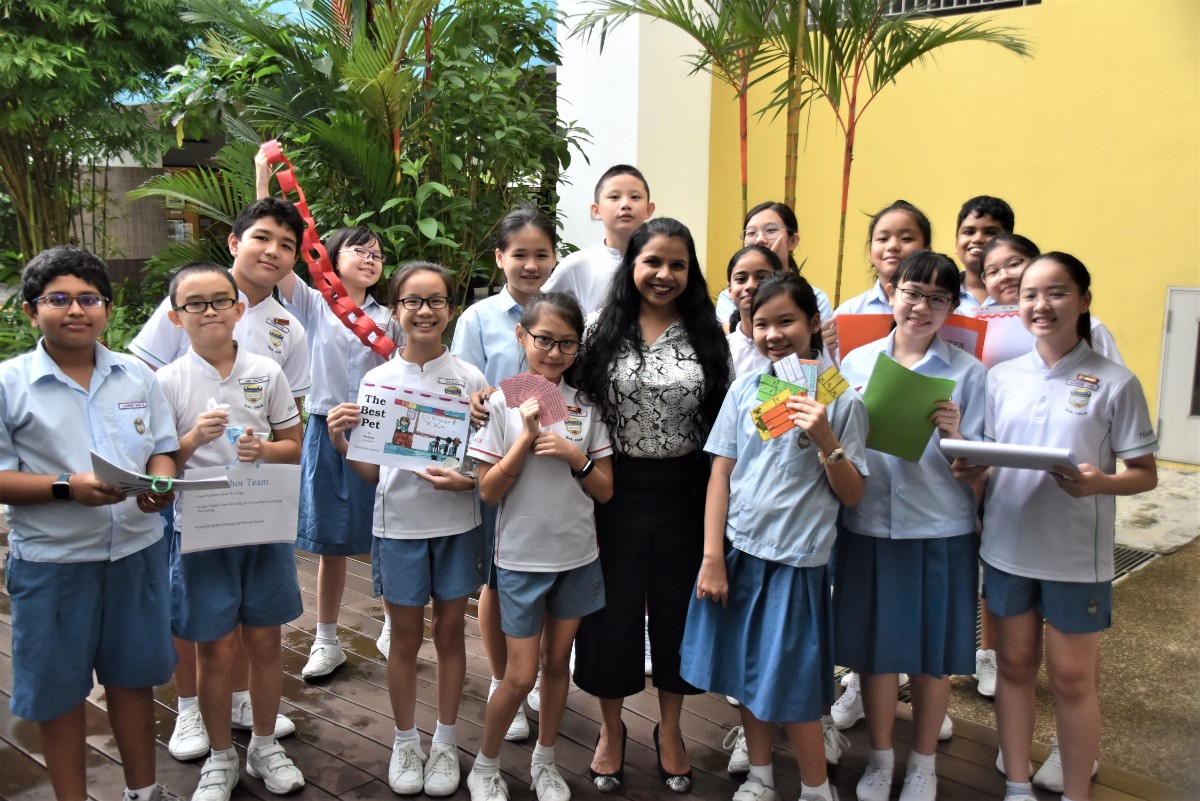Shanthi Deenathayalan, Guangyang Primary, President’s Award for Teachers 2020 Recipient
What does an English teacher do when a large number of her students are not keen on English but technology?
Get them to write letters that are emailed to students at partner schools abroad – from China to India, Germany and New Zealand, and now Southeast Asian countries. This was the idea behind Cultural Connections, a writing project in Shanthi Deenathayalan’s previous school, where she took on the role of Project Director.
She noticed that writing to students in other countries brought about “a change in their attitude towards the quality of written work,” said Shanthi. “They asked me for more time so that they could brush up their work. They checked and rechecked their spelling and grammar. For students to [be engaged in what they] write, they need to know the purpose, audience and context.”
For Shanthi’s students, who did not have many opportunities to travel, this was an exciting experience. They wrote about their country, their school experience and even shared recipes.
As Cheryl, her former student who graduated a few years ago said, “Previously, I always looked at computers as machines that help me type my work and play games. There’s a totally new aspect of computers being opened for me – as a communicative tool.”
To make matters even more thrilling, two years of writing would culminate in a trip abroad to visit their new-found buddies.
“The benefits have been manifold,” said Shanthi. “Students learn about different cultures and global issues, gain independence, and deepen friendships with their own classmates and those abroad. When abroad, students communicate in English, put on cultural performances about Singapore, and one of them even cooked meals using the recipes from Singapore for the host family.”
“It makes me so proud. I could see them developing into the next generation of Singaporeans – confident and ready to take on opportunities.”
Writing from around the world
At her current school, Guangyang Primary, Shanthi continues to show her students that writing is more than a paper exercise. Students now write back to their families while on immersion programmes.
While on a trip to the Central Post Office in Vietnam, Shanthi got her students to write postcards to their loved ones. One of her students quipped, “I thought we are on this trip to enjoy ourselves, but Mdm Shanthi is making us do a piece of Situational Writing.” Situational Writing is when students have to write to certain prescribed guidelines or a scenario.
“I was very pleased they were able to make the connection and understand that what they had learnt in class was applicable to the real world,” said Shanthi. “At that moment, it was a writing lesson come to life as many of them were trying to recall what they had learnt in class and then applying the skills in their writing. It was an ‘a-ha moment’ when they realised that language is alive.”
Shanthi is constantly on the look-out for such moments.
Primary 2 students read aloud stories that they have individually written in class to their parents during Parent-Teacher-Child conferences. Stories on values written by Primary 3 to 6 students are compiled into a book, which is read to the lower primary students.
While reading an interview as a piece of text, she got her Primary 5 students to experience it for themselves by interviewing school staff, from security guards to counsellors. This gave the little journalists the opportunity to put their writing and communication skills to practice.
“When students speak to and write for a real audience, they will be engaged. Don’t limit students to the classroom – take them out, or bring the world into the classroom,” she said.
Active students, active learning
Rarely will you find Shanthi’s students seated throughout a lesson. She wants to engage different aspects of the students – affective (belonging), behavioural (participating), cognitive.
When reading ‘Coolie Boy’ with her Primary 6 students, Shanthi decided to introduce Four Corners, an activity in which students can choose how they would like to retell the story. They do so by going to one of four different corners of the classroom, each representing a choice.
For example, Corner 1: use a comic strip to retell the story, Corner 2: act out the story, Corner 3: draw a timeline of the story, and Corner 4: write a script with the same theme. Students get to discuss in groups, share their ideas with one another, and present to the rest of their classmates.
“In all these activities, each student is given choices. When students get to make their own decisions, they are more engaged as they are responsible for their own learning.”
Even the more reserved students are motivated to come out of their shell as they get to partner with classmates who share the same interests.
Take for instance, Karin and Huey Shuen. Karin displayed her eloquence and her knack for acting and Huey Shuen charmed classmates with her illustrations – all hidden qualities that surprised the class.
These methods have won over Shanthi’s more traditional colleagues as well. After attending one of her workshops, a no-nonsense Science and Math teacher decided to incorporate Four Corners into his lesson. It was a hit with his students, and he thanked Shanthi for injecting more fun into his class.
Teachers lead teachers
In 2015, Shanthi started the practice of Open Classrooms at Guangyang Primary. (Open Classrooms is a practice in which colleagues sit in on others’ lessons to see different teaching methods in action.)
Initially, teachers were hesitant in embracing this concept. But over time, seeing how sincere Shanthi was in her efforts, more teachers took turns to open their classrooms for fellow teachers. This is now an accepted practice at Guangyang Primary.
The feedback and reflection that follow enable teachers to exchange good practices, improve their craft, find significance in their teaching (“knowing the why behind the what”) and discover new teaching strategies.
Shanthi perceives teaching as an art and teachers as artists who must constantly refine their craft. She often tells her colleagues: “Don’t rob our students of tomorrow by teaching the same way as today.”




-(1).jpeg)

